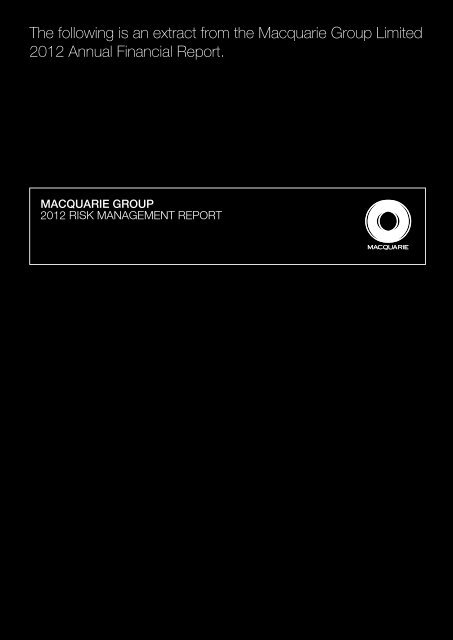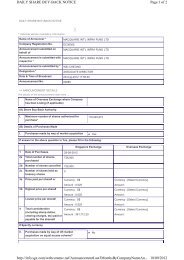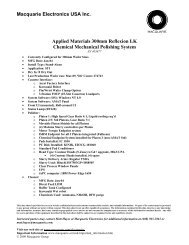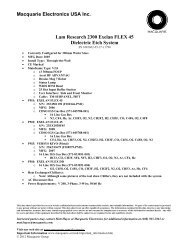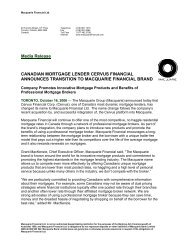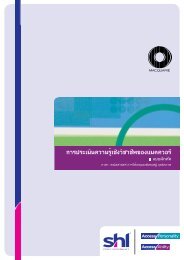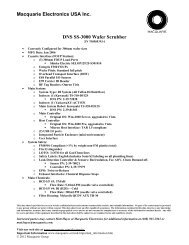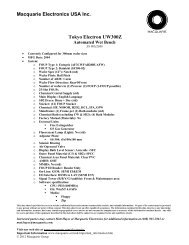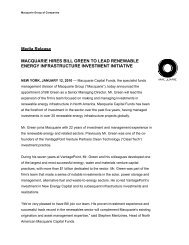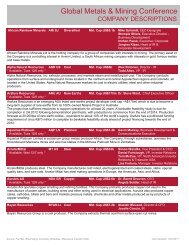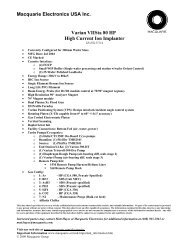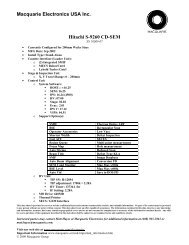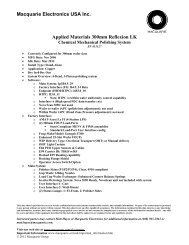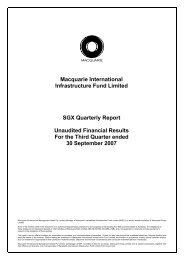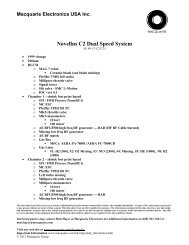Risk Management Policy and Systems - Macquarie
Risk Management Policy and Systems - Macquarie
Risk Management Policy and Systems - Macquarie
You also want an ePaper? Increase the reach of your titles
YUMPU automatically turns print PDFs into web optimized ePapers that Google loves.
The following is an extract from the <strong>Macquarie</strong> Group Limited<br />
2012 Annual Financial Report.<br />
MACQUARIE GROUP<br />
2012 RISK MANAGEMENT REPORT<br />
1
20<br />
20<br />
<strong>Macquarie</strong> Group Limited <strong>and</strong> its subsidiaries 2012 Annual Financial Report macquarie.com.au<br />
<strong>Macquarie</strong> Group Limited <strong>and</strong> its subsidiaries 2012 Annual Financial Report macquarie.com.au<br />
<strong>Risk</strong> <strong>Management</strong> Report<br />
<strong>Risk</strong> <strong>Management</strong> Report<br />
Introduction – <strong>Macquarie</strong>'s risk management<br />
framework<br />
<strong>Macquarie</strong>’s risk management framework is well established<br />
<strong>and</strong> proven. Some refinements have been made to the<br />
framework as <strong>Macquarie</strong>’s businesses have evolved over<br />
the past years. However, <strong>Macquarie</strong>’s core risk management<br />
principles have remained stable <strong>and</strong> continue to be highly<br />
effective. These are:<br />
Ownership of risk at the business level – Operating Group<br />
heads are responsible for identifying risks within their<br />
businesses <strong>and</strong> ensuring that they are managed<br />
appropriately. Before taking decisions, clear analysis<br />
of the risks is sought to ensure risks taken are consistent<br />
with the risk appetite <strong>and</strong> strategy of <strong>Macquarie</strong>. Business<br />
ownership of risk is an essential element in underst<strong>and</strong>ing<br />
<strong>and</strong> controlling risk.<br />
Underst<strong>and</strong>ing worst case outcomes – <strong>Macquarie</strong>'s risk<br />
management approach is based on examining the<br />
consequences of worst case outcomes <strong>and</strong> determining<br />
whether these are acceptable. This approach is adopted<br />
for all material risk types <strong>and</strong> is often achieved by stress<br />
testing. In particular, <strong>Macquarie</strong>'s market risk framework<br />
is based primarily on the application of stress tests, rather<br />
than statistical models. This approach was tested over the<br />
recent past. Shocks observed in the markets generally<br />
remained within <strong>Macquarie</strong>'s stress scenarios, resulting in<br />
very few of our worst case loss scenarios being exceeded.<br />
Whilst <strong>Macquarie</strong> operates a number of sophisticated<br />
quantitative risk management processes, the foundation<br />
of its risk management approach is the informed<br />
consideration of both quantitative <strong>and</strong> qualitative<br />
inputs by highly experienced professionals.<br />
Requirement for an independent signoff by risk<br />
management – <strong>Macquarie</strong> places significant importance<br />
on having a strong independent <strong>Risk</strong> <strong>Management</strong> Group<br />
(RMG) which is charged with signing off all material risk<br />
acceptance decisions. It is essential RMG has the capability<br />
to do this effectively <strong>and</strong> hence RMG has invested in<br />
recruiting skilled professionals, many with previous trading<br />
or investment banking experience. For all material proposals,<br />
RMG's opinion is sought at an early stage in the decision<br />
making process <strong>and</strong> independent input from RMG on risk<br />
<strong>and</strong> return is included in the approval document submitted<br />
to senior management.<br />
<strong>Macquarie</strong> determines its overall appetite for risk with<br />
reference to earnings <strong>and</strong> not just capital. Aggregate risk is<br />
expressed by setting a Global <strong>Risk</strong> Limit designed to ensure<br />
that in a prolonged <strong>and</strong> severe downturn, losses will be<br />
covered by earnings <strong>and</strong> surplus capital <strong>and</strong> market<br />
confidence in <strong>Macquarie</strong> is maintained.<br />
<strong>Macquarie</strong>’s risk culture is well established – <strong>Macquarie</strong><br />
recognises that an effective risk management framework<br />
involves more than just robust controls. <strong>Macquarie</strong>'s risk<br />
culture, which is less tangible, is equally as important <strong>and</strong><br />
at <strong>Macquarie</strong> the risk culture remains strong, <strong>and</strong> controls<br />
are respected by staff. Key aspects supporting this culture<br />
include:<br />
— <strong>Macquarie</strong>'s businesses are fundamentally client based.<br />
Therefore, across <strong>Macquarie</strong>, greater emphasis is<br />
placed on fostering long-term relationships with our<br />
clients <strong>and</strong> building franchise businesses as opposed<br />
to short-term profits from proprietary trading.<br />
— Consideration of worst-case scenarios is part of<br />
everyday risk controls rather than supplementary to<br />
them. Even though the worst case scenarios are often<br />
in excess of what has been historically observed, they<br />
play a major role in influencing <strong>and</strong> limiting positions<br />
particularly for extreme loss events.<br />
We apply limits to contingent losses from a<br />
40 per cent gap move in stock prices. This<br />
effectively constrains trading divisions from<br />
issuing well out of the money options <strong>and</strong><br />
encourages hedging of extreme loss<br />
events. We have over 13,000 contingent<br />
loss limits that consider a variety of worst<br />
case scenarios.<br />
— The role of risk management staff is one of active<br />
engagement in risk-taking decisions. In accordance<br />
with the principle of risk ownership, the primary risk<br />
analysis <strong>and</strong> initial decisions to reject or accept a<br />
transaction are taken by Operating Groups. In its review<br />
of a new proposal, RMG provides an independent<br />
confirmation of the risk acceptance decision. RMG<br />
works closely with the deal team <strong>and</strong> shares the goal<br />
of making the transaction successful by requiring<br />
improvements to the transaction terms where<br />
applicable. Strong emphasis is placed on transferring<br />
knowledge to transaction teams so that the same risk<br />
management principles are applied to future proposals<br />
from an early stage.<br />
— <strong>Macquarie</strong>’s remuneration policy for senior management<br />
encourages a long-term view in decision making. It<br />
discourages excessive risk taking as incentives are<br />
aligned with the long-term profitability of the firm through<br />
retention of remuneration <strong>and</strong> equity participation. The<br />
principles behind our current remuneration structure<br />
have been in place for many years.
<strong>Risk</strong> governance structure<br />
<strong>Risk</strong> management is sponsored by the <strong>Macquarie</strong> Group<br />
Board (Board), <strong>and</strong> is a top priority for senior managers,<br />
starting with the Managing Director <strong>and</strong> CEO.<br />
The Head of RMG, as <strong>Macquarie</strong>’s Chief <strong>Risk</strong> Officer, is a<br />
member of <strong>Macquarie</strong>’s Executive Committee <strong>and</strong> reports<br />
directly to the Managing Director <strong>and</strong> CEO. The Chief <strong>Risk</strong><br />
Officer has a secondary reporting line to the Board <strong>Risk</strong><br />
Committee which approves the replacement, appointment,<br />
reassignment or dismissal of the Chief <strong>Risk</strong> Officer.<br />
The Board oversees the risk appetite <strong>and</strong> profile of<br />
<strong>Macquarie</strong> <strong>and</strong> ensures that business developments are<br />
consistent with the risk appetite <strong>and</strong> goals of <strong>Macquarie</strong>.<br />
All Board members are members of the Board <strong>Risk</strong><br />
Committee. The Board <strong>Risk</strong> Committee has responsibility for<br />
ensuring an appropriate risk management framework –<br />
including the establishment of policies for the control of risk –<br />
is in place. The Board <strong>Risk</strong> Committee receives information<br />
on the risk profile of <strong>Macquarie</strong>, breaches of the policy<br />
framework <strong>and</strong> external developments which may have<br />
some impact on the effectiveness of the risk management<br />
framework. It also approves significant changes to risk<br />
management policies <strong>and</strong> framework <strong>and</strong> approves<br />
<strong>Macquarie</strong>’s risk appetite. The Board <strong>Risk</strong> Committee<br />
is assisted by the following Committees:<br />
— The Board Audit Committee (BAC) monitors the<br />
effectiveness of internal controls with <strong>Macquarie</strong>’s<br />
external auditor, management <strong>and</strong> the Head of Internal<br />
Audit. The BAC also monitors <strong>and</strong> reviews the<br />
effectiveness of the external auditors <strong>and</strong> the Internal<br />
Audit <strong>and</strong> Credit Assurance functions<br />
— The Board Remuneration Committee liaises with the<br />
Board <strong>Risk</strong> Committee <strong>and</strong> the Chief <strong>Risk</strong> Officer to<br />
ensure there is a properly integrated approach to<br />
remuneration that appropriately reflects risk<br />
— The Board Governance <strong>and</strong> Compliance Committee<br />
(BGCC) reviews <strong>Macquarie</strong>’s corporate governance<br />
arrangements <strong>and</strong> compliance matters. The BGCC<br />
also has oversight of Work Health <strong>and</strong> Safety <strong>and</strong><br />
environmental matters on behalf of the Board.<br />
Committees exist at the executive management level to<br />
ensure that the necessary elements of expertise are focused<br />
on specific risk areas. The <strong>Macquarie</strong> <strong>and</strong> <strong>Macquarie</strong> Bank<br />
Executive Committees <strong>and</strong> the <strong>Macquarie</strong> Operations<br />
Review Committee focus on strategic issues, operational<br />
issues, material transactions <strong>and</strong> review the performance of<br />
<strong>Macquarie</strong> on a monthly basis. Beneath this level, there are<br />
other committees where senior specialists focus on specific<br />
risks as appropriate. The Market <strong>Risk</strong> Committee <strong>and</strong> Asset<br />
<strong>and</strong> Liability Committee are examples of these committees.<br />
While committees oversee <strong>Macquarie</strong>’s<br />
risk appetite <strong>and</strong> acceptance process,<br />
risk acceptance decisions are ultimately<br />
delegated to individuals to ensure that<br />
approvers are individually accountable<br />
when signing off on risk acceptance<br />
decisions.<br />
<strong>Risk</strong> <strong>Management</strong> Group<br />
RMG’s oversight of risk is based on the following five<br />
principles:<br />
Independence<br />
RMG, which is responsible for assessing <strong>and</strong> monitoring<br />
risks across <strong>Macquarie</strong>, is independent of the operating<br />
areas of <strong>Macquarie</strong>, <strong>and</strong> the Head of RMG, as <strong>Macquarie</strong>’s<br />
Chief <strong>Risk</strong> Officer, reports directly to the Managing Director<br />
<strong>and</strong> CEO with a secondary reporting line to the Board <strong>Risk</strong><br />
Committee. RMG approval is required for all material risk<br />
acceptance decisions.<br />
Centralised prudential management<br />
RMG’s responsibility covers the whole of <strong>Macquarie</strong>.<br />
Therefore, it can assess risks from a <strong>Macquarie</strong>-wide<br />
perspective <strong>and</strong> provide a consistent approach across<br />
all operating areas.<br />
Approval of all new business activities<br />
Operating areas cannot undertake new businesses or<br />
activities, offer new products, or enter new markets without<br />
first consulting RMG. RMG reviews <strong>and</strong> assesses risk <strong>and</strong><br />
sets prudential limits. Where appropriate, these limits are<br />
approved by the Executive Committee <strong>and</strong> the Board.<br />
Continuous assessment<br />
RMG continually reviews risks to account for changes in<br />
market circumstances <strong>and</strong> developments within <strong>Macquarie</strong>’s<br />
operating areas.<br />
Frequent monitoring<br />
Centralised systems exist to allow RMG to monitor credit<br />
<strong>and</strong> market risks daily. RMG staff liaise closely with operating<br />
<strong>and</strong> support divisions.<br />
21<br />
21
22 22<br />
<strong>Macquarie</strong> Group Limited <strong>and</strong> its subsidiaries 2012 Annual Financial Report macquarie.com.au<br />
<strong>Macquarie</strong> Group Limited <strong>and</strong> its subsidiaries 2012 Annual Financial Report macquarie.com.au<br />
<strong>Risk</strong> <strong>Management</strong> Report<br />
continued<br />
RMG structure <strong>and</strong> resourcing<br />
While RMG is structured into specialist teams as detailed below, we employ an integrated approach to risk analysis <strong>and</strong><br />
management across risk classes. RMG’s assessment <strong>and</strong> monitoring of risks involves a collaborative effort across the teams<br />
to ensure that a detailed analysis takes place both at the individual <strong>and</strong> aggregate risk level.<br />
The change in staffing levels within RMG is in line with the changes in staffing overall at <strong>Macquarie</strong>. RMG staff numbers as at<br />
31 March 2012 were 471 which is a 7 per cent decrease over the year.<br />
Ratio of RMG headcount to total <strong>Macquarie</strong> 1<br />
RMG Headcount Ratio of RMG to MGL<br />
600<br />
500<br />
400<br />
300<br />
200<br />
100<br />
Credit Credit<br />
Analytics<br />
- Credit <strong>Risk</strong><br />
- Country <strong>Risk</strong><br />
- Equity <strong>Risk</strong><br />
Investments<br />
- Equity<br />
Underwriting<br />
1 Headcount numbers only include permanent, active staff<br />
(full-time <strong>and</strong> part-time). Historical figures have not been<br />
restated to include business compliance staff who joined<br />
RMG in FY2011.<br />
4.0%<br />
3.5%<br />
3.0%<br />
2.5%<br />
2.0%<br />
1.5%<br />
1.0%<br />
0.5%<br />
0 0%<br />
FY02<br />
FY03<br />
- Credit<br />
exposure<br />
measurement<br />
FY04<br />
FY05<br />
FY06<br />
FY07<br />
Prudential,<br />
Capital &<br />
Markets<br />
- Prudential<br />
Regulation<br />
- Economic<br />
Capital<br />
- Liquidity <strong>Risk</strong><br />
FY08<br />
FY09<br />
FY10<br />
FY11<br />
Market<br />
<strong>Risk</strong><br />
FY12<br />
RMG<br />
Head of RMG<br />
Chief <strong>Risk</strong> Officer<br />
Quantitative<br />
Applications<br />
Division<br />
- Market <strong>Risk</strong> - Independent<br />
model review<br />
Operational<br />
<strong>Risk</strong><br />
- Operational<br />
<strong>Risk</strong><br />
Effective risk management is not only a<br />
function of disciplined processes but also<br />
of imaginative analysis by talented<br />
individuals.<br />
RMG attracts high calibre c<strong>and</strong>idates. It<br />
recruits experienced individuals both from<br />
within <strong>Macquarie</strong> <strong>and</strong> externally <strong>and</strong> is a<br />
source of talent for <strong>Macquarie</strong>’s Operating<br />
Groups when recruiting.<br />
23<br />
Compliance<br />
AML/CTF<br />
<strong>Risk</strong><br />
- Regulatory<br />
<strong>Risk</strong><br />
- Reputation<br />
<strong>Risk</strong><br />
Data<br />
<strong>Policy</strong><br />
- Data quality<br />
<strong>and</strong> integrity<br />
Board<br />
Audit<br />
Committee<br />
Internal<br />
Audit<br />
- Independent<br />
assessment<br />
of design<br />
<strong>and</strong><br />
effectiveness<br />
of control<br />
framework
To ensure that, on a global basis, risks are managed in a<br />
controlled manner, 52 per cent of total RMG staff as at<br />
31 March 2012 were based outside of Australia. All offices<br />
are subject to the same risk management controls <strong>and</strong><br />
st<strong>and</strong>ards. This is supported by regular staff communication<br />
<strong>and</strong> visits to international offices.<br />
Consistent with the concept of Operating Groups owning<br />
risk, specific day-to-day operations are more appropriately<br />
discharged <strong>and</strong> embedded within the Operating Groups.<br />
The majority of operational risk <strong>and</strong> compliance functions<br />
are therefore discharged within the Operating Groups.<br />
Business-aligned compliance staff ensure that day-to-day<br />
compliance obligations are discharged at the business<br />
level whilst Business Operational <strong>Risk</strong> Managers are<br />
appointed by the Operating Group Heads to be their<br />
representative on operational risk management matters,<br />
<strong>and</strong> act as their delegate in ensuring that operational risk<br />
<strong>and</strong> st<strong>and</strong>ards are addressed appropriately within their<br />
division. All business-aligned compliance staff have a<br />
reporting line to the regional Head of Compliance, <strong>and</strong><br />
ultimately to the RMG divisional Head of Compliance;<br />
whilst divisional operational risk staff have functional<br />
reporting lines to the RMG divisional head of Operational<br />
<strong>Risk</strong>.<br />
New business <strong>and</strong> acquisitions<br />
Innovation is encouraged across <strong>Macquarie</strong>’s businesses<br />
<strong>and</strong> activities. Therefore, it is important that all elements of<br />
new business initiatives are well understood before<br />
commencement.<br />
All new business initiatives must be signed off by RMG<br />
prior to commencement.<br />
The formal new business approval process requires all<br />
relevant risks (market, credit, equity, legal, compliance,<br />
taxation, accounting, operational <strong>and</strong> systems are examples)<br />
to be reviewed, to ensure that all risks are identified, <strong>and</strong><br />
addressed prior to implementation (including ongoing risk<br />
monitoring processes). The approval of RMG, Finance<br />
Division, Taxation Division, Group Legal <strong>and</strong> other relevant<br />
stakeholders within <strong>Macquarie</strong> is obtained. RMG also checks<br />
that all necessary internal approvals are obtained prior to<br />
commencement.<br />
For all material transactions, independent input from RMG<br />
on the risk <strong>and</strong> return of the transaction is included in the<br />
approval document submitted to senior management.<br />
The Operational <strong>Risk</strong> function within RMG oversees the<br />
new product <strong>and</strong> business approval process.<br />
RMG Internal Audit performs an audit of the operations of<br />
any significant new businesses based on an assessment of<br />
the associated risk faced by <strong>Macquarie</strong>. The audit typically<br />
takes place within six to 12 months following acquisition or<br />
launch <strong>and</strong> includes confirmation that operations are in line<br />
with the new product approval document.<br />
<strong>Risk</strong> management <strong>and</strong> monitoring<br />
The risk management framework incorporates active<br />
management <strong>and</strong> monitoring of market, credit, equity,<br />
liquidity, operational, compliance, regulatory <strong>and</strong> legal<br />
risks. It is designed to ensure policies <strong>and</strong> procedures are<br />
in place to manage the risks arising within each division.<br />
Application varies in detail from one part of <strong>Macquarie</strong> to<br />
another; however, the same risk management framework<br />
applies across all business activities.<br />
Equity risk<br />
Equity risk is the risk of loss arising from banking book<br />
equity-type exposures. These exposures include:<br />
— holdings in specialised funds managed by <strong>Macquarie</strong><br />
— principal exposures taken by <strong>Macquarie</strong> Capital,<br />
including direct investments in entities external to<br />
<strong>Macquarie</strong><br />
— property equity, including property trusts <strong>and</strong> direct<br />
property investments<br />
— lease residuals<br />
— other equity, including investments in resource<br />
companies.<br />
Equity <strong>Risk</strong> Limit<br />
All of the above equity risk positions are subject to an<br />
aggregate Equity <strong>Risk</strong> Limit (ERL). The ERL is set by the<br />
Board with reference to the <strong>Risk</strong> Appetite Test which is<br />
described further in the economic capital section. In setting<br />
the limit, consideration is also given to the level of earnings,<br />
capital <strong>and</strong> market conditions. The limit is reviewed on a<br />
semi-annual basis by RMG <strong>and</strong> the results of the review<br />
are reported to the Operations Review Committee <strong>and</strong><br />
the Board <strong>Risk</strong> Committee.<br />
Concentrations within the equity portfolio are managed by<br />
a number of additional limits approved by the Executive<br />
Committee <strong>and</strong>/or the Board. These include limits on:<br />
— property equity investments<br />
— investments in the resources sector<br />
— lease residuals (by type of leased asset)<br />
— co-investments <strong>and</strong> other assets of <strong>Macquarie</strong> Capital.<br />
Transaction review <strong>and</strong> approval process<br />
The division executing the transaction is responsible for<br />
due diligence <strong>and</strong> risk analysis of each equity investment.<br />
For material deals, RMG undertakes shadow due diligence<br />
<strong>and</strong> performs a comprehensive analysis of all risks <strong>and</strong><br />
potential losses associated with the acquisition such as:<br />
— market <strong>and</strong> credit risks<br />
— regulatory, capital, liquidity <strong>and</strong> compliance<br />
requirements<br />
— business, operational <strong>and</strong> reputation risks.<br />
All material equity risk positions are subject to approval by<br />
RMG <strong>and</strong> by the Managing Director <strong>and</strong> CEO, Executive<br />
Committee <strong>and</strong> the Board, depending on the size <strong>and</strong><br />
nature of the risk. RMG ensures that the transaction is<br />
correctly represented to the relevant approvers.<br />
23<br />
23
24<br />
24<br />
<strong>Macquarie</strong> Group Limited <strong>and</strong> its subsidiaries 2012 Annual Financial Report macquarie.com.au<br />
<strong>Macquarie</strong> Group Limited <strong>and</strong> its subsidiaries 2012 Annual Financial Report macquarie.com.au<br />
<strong>Risk</strong> <strong>Management</strong> Report<br />
continued<br />
Credit risk<br />
Credit <strong>Risk</strong> is defined as the risk of a counterparty failing<br />
to complete its contractual obligations when they fall due.<br />
The consequent loss is either the amount of the loan not<br />
paid back or the loss incurred in replicating a trading<br />
contract with a new counterparty.<br />
The RMG Credit team maintains a comprehensive <strong>and</strong><br />
robust framework for the identification, analysis <strong>and</strong><br />
monitoring of credit risks arising within each business.<br />
Key aspects of this framework are discussed below.<br />
Analysis <strong>and</strong> approval of exposures<br />
The <strong>Macquarie</strong> <strong>and</strong> <strong>Macquarie</strong> Bank Boards are<br />
responsible for establishing the framework for approving<br />
credit exposures. The Boards delegate discretions to<br />
approve credit exposure to designated individuals within<br />
<strong>Macquarie</strong> whose capacity to exercise authority prudently<br />
has been assessed.<br />
Operating Groups are assigned modest levels of credit<br />
discretions. Credit exposures above these levels are<br />
assessed independently by RMG <strong>and</strong> approved by<br />
senior RMG staff, the CEO <strong>and</strong> the Boards as required.<br />
<strong>Macquarie</strong> enforces a strict 'no limit, no dealing' rule;<br />
all proposed transactions are analysed <strong>and</strong> approved<br />
by designated individuals before they can proceed.<br />
All credit exposures are reviewed at least once a year,<br />
or more frequently if required.<br />
Independent analysis<br />
The RMG Credit team provides independent analysis of<br />
credit risk exposures. The team works closely with the<br />
Operating Groups to identify the risks inherent in<br />
<strong>Macquarie</strong>’s businesses, <strong>and</strong> apply analysis<br />
commensurate to the level <strong>and</strong> nature of risks.<br />
Credit risk analysis is focused on ensuring that risks have<br />
been fully identified <strong>and</strong> that the downside risk is properly<br />
understood so that a balanced assessment can be made<br />
of the worst case outcome against the expected rewards.<br />
Downside analysis includes stress testing <strong>and</strong> scenario<br />
analysis.<br />
<strong>Macquarie</strong> does not rely on quantitative models to assess<br />
credit risk in our wholesale portfolio, but uses fundamental<br />
credit analysis to make credit risk acceptance decisions.<br />
<strong>Macquarie</strong> Group ratings<br />
<strong>Macquarie</strong> relies on its own independent assessment of<br />
credit risk. Third party credit assessments are considered<br />
as an input into the analysis but are not considered to be<br />
a sufficient basis for decision making.<br />
<strong>Macquarie</strong> has established a proprietary internal credit rating<br />
framework to assess counterparty credit risk. <strong>Macquarie</strong><br />
ratings are used to estimate the likelihood of the rated entity<br />
defaulting on financial obligations. The <strong>Macquarie</strong> ratings<br />
system ensures a consistent assessment of borrower <strong>and</strong><br />
transaction characteristics across <strong>Macquarie</strong> <strong>and</strong> provides<br />
the mechanism for meaningful differentiation of credit risk.<br />
Each <strong>Macquarie</strong> rating is assigned a Probability of Default<br />
estimate. Credit limits <strong>and</strong> exposures are also allocated a<br />
Loss Given Default ratio reflecting the estimated economic<br />
loss in the event of default occurring.<br />
All customer limits <strong>and</strong> exposures are allocated a <strong>Macquarie</strong><br />
rating on a 1–17 scale, which broadly corresponds to<br />
St<strong>and</strong>ard & Poors’ <strong>and</strong> Moody's Investor Services credit<br />
ratings.<br />
<strong>Macquarie</strong> has a Credit Assurance function within<br />
RMG which independently verifies the effectiveness<br />
of <strong>Macquarie</strong>’s credit risk management.<br />
Measuring <strong>and</strong> monitoring exposures<br />
Credit exposures for loans are evaluated as the full face<br />
value or acquisition cost when acquired in the secondary<br />
market.<br />
Credit exposures for derivatives are a function of potential<br />
market movements <strong>and</strong> are assessed by assuming that<br />
low probability stressed market movements occur <strong>and</strong> that<br />
<strong>Macquarie</strong> has to go to the market to replace a defaulting<br />
deal at the worst possible time during the term of the<br />
transaction. RMG Credit Analytics proposes <strong>and</strong> reviews<br />
the stresses which are applied in order to determine high<br />
confidence level counterparty exposures. These stresses<br />
are back-tested to ensure that they would have provided<br />
the required confidence level over a representative historic<br />
period. Credit stresses are determined using a combination<br />
of fundamental <strong>and</strong> technical analysis.<br />
Where trading gives rise to settlement risk, this exposure is<br />
assessed as the full face value of the settlement amount.<br />
All credit exposures are monitored regularly against limits.<br />
Credit exposures which fluctuate through time are updated<br />
daily. These include off-balance sheet exposures such as<br />
swaps, forward contracts <strong>and</strong> options, which are assessed<br />
using sophisticated valuation techniques.<br />
To mitigate credit risk, <strong>Macquarie</strong> makes use of margining<br />
<strong>and</strong> other forms of collateral or credit enhancement<br />
techniques (including guarantees <strong>and</strong> letters of credit, the<br />
purchase of credit default swaps <strong>and</strong> mortgage insurance)<br />
where appropriate.<br />
On <strong>and</strong> off-balance sheet exposures are considered<br />
together <strong>and</strong> treated identically for approval, monitoring<br />
<strong>and</strong> reporting purposes.<br />
A review of the credit portfolio which involves analysing<br />
credit concentrations by counterparty, country, risk type,<br />
industry <strong>and</strong> credit quality is carried out <strong>and</strong> reported to<br />
<strong>Macquarie</strong>’s Operations Review Committee quarterly <strong>and</strong><br />
Board semi-annually. Policies are in place to manage<br />
credit risk <strong>and</strong> avoid unacceptable concentrations to<br />
any counterparty or country.
Loan impairment review<br />
All exposures are subject to recurring review <strong>and</strong><br />
assessment for possible impairment. Provisions for loan<br />
losses are based on an incurred loss model, which<br />
recognises a provision where there is objective evidence<br />
of impairment at each balance date, <strong>and</strong> is calculated based<br />
on the discounted values of expected future cash flows.<br />
Specific provisions are recognised where specific impairment<br />
is identified. The rest of the loans are placed into pools of<br />
assets with similar risk profiles <strong>and</strong> collectively assessed<br />
for losses that have been incurred but not yet identified.<br />
Impaired assets continue to decline from the past year,<br />
driven by a combination of write-backs, write-downs <strong>and</strong><br />
foreign currency movements.<br />
Ratio of provisions <strong>and</strong> impaired assets to loans, advances <strong>and</strong> leases<br />
Collective provision to loans, advances <strong>and</strong> leases (Balance sheet) �<br />
Net impaired assets to loans, advances <strong>and</strong> leases (Balance sheet) �<br />
Net credit losses to loans, advances <strong>and</strong> leases (Income statement) –<br />
8.0%<br />
7.0%<br />
6.0%<br />
5.0%<br />
4.0%<br />
3.0%<br />
2.0%<br />
1.0%<br />
0.0%<br />
-1.0%<br />
Country risk<br />
Country risk is defined as losses arising from events in a<br />
country which include an act of government, war, terrorism,<br />
civil strife or economic crisis.<br />
The Country <strong>Risk</strong> <strong>Policy</strong> guides the management of<br />
<strong>Macquarie</strong>’s country risk. Countries are grouped into<br />
categories based on the country’s risk profile. Before any<br />
exposure is taken in a country which is considered to be<br />
high risk, a review of the economic, political <strong>and</strong> operating<br />
environment is undertaken to determine the level of exposure<br />
that is considered to be acceptable. Where appropriate,<br />
measures to mitigate country risk are put in place.<br />
1991 1992 1993 1994 1995 1996 1997 1998 1999 2000 2001 2002 2003 2004 2005 2006 2007 2008 2009 2010 2011 2012<br />
Notes:<br />
— Loan assets exclude securitised mortgages, securitised <strong>Macquarie</strong> Capital loans/leases, segregated future funds <strong>and</strong><br />
receivables in the form of fees.<br />
— Net impaired assets <strong>and</strong> net losses exclude investment securities.<br />
— Collective provision (as per Note 12 of the Financial Report) is intended to cover losses inherent in the existing overall credit<br />
portfolio which are not yet specifically identifiable.<br />
— Net credit losses represent total profit <strong>and</strong> loss impact in the stated period due to additional specific provisions <strong>and</strong> direct<br />
write-offs net of any write-backs.<br />
— Please refer to Note 13 of the Financial Report for further information on impaired assets.<br />
25 25
26 26<br />
<strong>Macquarie</strong><br />
<strong>Macquarie</strong><br />
Group<br />
Group<br />
Limited<br />
Limited<br />
<strong>and</strong><br />
<strong>and</strong><br />
its<br />
its<br />
subsidiaries<br />
subsidiaries<br />
2012<br />
2012<br />
Annual<br />
Annual<br />
Financial<br />
Financial<br />
Report<br />
Report macquarie.com.au<br />
macquarie.com.au<br />
<strong>Risk</strong> <strong>Management</strong> Report<br />
continued<br />
Operational risk<br />
<strong>Macquarie</strong> defines operational risk as the risk of loss<br />
resulting from inadequate or failed internal processes, people<br />
<strong>and</strong> systems or from external events. <strong>Macquarie</strong> has<br />
established procedures <strong>and</strong> controls to manage market,<br />
credit, reputation <strong>and</strong> strategic risks. The potential for failure<br />
or inadequacy in these procedures <strong>and</strong> controls would be<br />
classified as an operational risk. Operational risk failures<br />
could lead to reputation damage, financial loss or regulatory<br />
consequences.<br />
RMG is responsible for ensuring an appropriate framework<br />
exists to identify, assess <strong>and</strong> manage operational risk <strong>and</strong><br />
that resources are available to support it. RMG is also<br />
responsible for <strong>Macquarie</strong>’s operational risk capital<br />
measurement methodology.<br />
In general, changes in <strong>Macquarie</strong>’s operational risk profile<br />
are the net result of greater innovation <strong>and</strong> growth. This<br />
is offset by constant gradual adaptation <strong>and</strong> development<br />
of the control environment to accommodate new risks.<br />
Operational <strong>Risk</strong> <strong>Management</strong> framework<br />
<strong>Macquarie</strong>’s Operational <strong>Risk</strong> <strong>Management</strong> Framework<br />
(ORMF) is designed to identify, assess <strong>and</strong> manage<br />
operational risks within the organisation. The key objectives<br />
of the framework are as follows:<br />
— risk identification, analysis <strong>and</strong> acceptance<br />
— execution <strong>and</strong> monitoring of risk management practices<br />
— reporting <strong>and</strong> escalation of risk information on a routine<br />
<strong>and</strong> exception basis.<br />
Businesses carry out elements of the ORMF in a manner<br />
that is tailored to their specific operational risk profile.<br />
However, to ensure consistency <strong>and</strong> minimum st<strong>and</strong>ards<br />
the framework includes the following m<strong>and</strong>atory elements:<br />
— a robust change management process to ensure<br />
operational risks in new activities or products are<br />
identified, addressed <strong>and</strong> managed prior to<br />
implementation<br />
— a semi-annual operational risk self assessment process<br />
to identify operational risks at the business level, assess<br />
controls <strong>and</strong> develop action plans to address<br />
deficiencies<br />
— recording of operational risk incidents into a centralised<br />
reporting system. Incidents are analysed to identify<br />
trends <strong>and</strong> establish lessons learnt on the effectiveness<br />
of controls<br />
— allocation of operational risk capital to all <strong>Macquarie</strong><br />
businesses as a tool to further encourage positive<br />
behavior in <strong>Macquarie</strong>’s day-to-day management<br />
of operational risk<br />
— <strong>Macquarie</strong>-wide policies which require a consistent<br />
approach <strong>and</strong> minimum st<strong>and</strong>ards on specific<br />
operational risk matters<br />
— embedded operational risk representatives in Operating<br />
Groups who act as delegates of the business manager.<br />
These representatives ensure operational risks are<br />
addressed appropriately <strong>and</strong> that the ORMF is<br />
executed within their area.<br />
<strong>Macquarie</strong>’s operational risk capital framework<br />
<strong>Macquarie</strong>’s framework for operational risk capital has two<br />
main elements:<br />
— an annual scenario approach for modelling operational<br />
risk losses <strong>and</strong> to determine operational risk capital<br />
— a quarterly scorecard analysis which is used to update<br />
operational risk capital between scenario analyses, <strong>and</strong><br />
as a basis for updating the allocation of capital to<br />
businesses.<br />
Operational risk scenarios identify key risks that, while very<br />
low in probability, may result in very high impact losses. In<br />
identifying the potential for such losses consideration is given<br />
to the individual statistical distribution for each scenario,<br />
external loss data, internal loss data, risk <strong>and</strong> control factors<br />
determined by the operational risk self assessments, <strong>and</strong> the<br />
contribution of expert opinion from businesses. Results are<br />
then modelled to determine the operational risk component<br />
of regulatory capital required to be held by <strong>Macquarie</strong> at the<br />
99.9th percentile level. Monte Carlo techniques are used to<br />
aggregate these individual distributions to determine a<br />
<strong>Macquarie</strong>-wide operational risk loss distribution.<br />
Over time operational risk capital changes to reflect:<br />
— new business activity, businesses growth <strong>and</strong> significant<br />
change in activity which may require new or increased<br />
loss scenarios <strong>and</strong>/or an increased loss probability<br />
— decreases in the probability of loss as business changes<br />
bed down <strong>and</strong> the control environment continues to<br />
mature, reducing the capital requirement<br />
— changes in the external environment such as new<br />
regulations or movements in the economic cycle that<br />
also influence scenario estimates.<br />
<strong>Macquarie</strong> allocates capital to individual businesses. The<br />
capital allocation effectively rewards positive risk behaviour,<br />
<strong>and</strong> penalises increased risks. This is done using scorecards<br />
which measure changes in a number of key factors such as<br />
the size <strong>and</strong> complexity of the business, risk <strong>and</strong> control<br />
assessments, incident <strong>and</strong> exception management <strong>and</strong><br />
governance. The quarterly change in the sum of divisional<br />
capital is also used as an estimate to update the <strong>Macquarie</strong><br />
capital requirement between annual assessments.
Market risk<br />
Market risk is the exposure to adverse changes in the value<br />
of <strong>Macquarie</strong>’s trading portfolios as a result of changes in<br />
market prices or volatility. <strong>Macquarie</strong> is exposed to the<br />
following risks in each of the major markets in which it<br />
trades:<br />
— foreign exchange <strong>and</strong> bullion – changes in spot <strong>and</strong><br />
forward exchange rates <strong>and</strong> bullion prices <strong>and</strong> the<br />
volatility of exchange rates <strong>and</strong> bullion prices<br />
— interest rates <strong>and</strong> debt securities – changes in the level,<br />
shape <strong>and</strong> volatility of yield curves, the basis between<br />
different debt securities <strong>and</strong> derivatives <strong>and</strong> credit<br />
margins<br />
— equities – changes in the price <strong>and</strong> volatility of individual<br />
equities, equity baskets <strong>and</strong> equity indices, including<br />
the risks arising from equity underwriting activity<br />
— commodities <strong>and</strong> energy – changes in the price <strong>and</strong><br />
volatility of base metals, agricultural commodities <strong>and</strong><br />
energy products.<br />
<strong>Macquarie</strong> is also exposed to the correlation of market<br />
prices <strong>and</strong> rates within <strong>and</strong> across markets.<br />
All trading activities contain calculated<br />
elements of risk taking. <strong>Macquarie</strong> is<br />
prepared to accept such risks provided<br />
they are within agreed limits, independently<br />
<strong>and</strong> correctly identified, calculated <strong>and</strong><br />
monitored by RMG, <strong>and</strong> reported to senior<br />
management on a regular basis.<br />
Trading market risk<br />
RMG monitors positions within <strong>Macquarie</strong> according to<br />
a limit structure which sets limits for all exposures in all<br />
markets. Limits are applied at a granular level to individual<br />
trading desks, through increasing levels of aggregation to<br />
divisions <strong>and</strong> Operating Groups, <strong>and</strong> ultimately, <strong>Macquarie</strong>.<br />
This approach removes the need for future correlations or<br />
scenarios to be precisely predicted as all risks are stressed<br />
to the extreme <strong>and</strong> accounted for within the risk profile<br />
agreed for each business <strong>and</strong> <strong>Macquarie</strong> in aggregate.<br />
Limits are approved by senior management with appropriate<br />
authority for the size <strong>and</strong> nature of the risk, <strong>and</strong> <strong>Macquarie</strong><br />
adheres to a strict ‘no limit, no dealing’ policy. If a product<br />
or position has not been authorised <strong>and</strong> given a limit<br />
structure by RMG, then it cannot be traded. Material<br />
breaches of the approved limit structure are communicated<br />
monthly to the <strong>Macquarie</strong> <strong>and</strong> <strong>Macquarie</strong> Bank Boards.<br />
RMG sets three complementary limit structures:<br />
— contingent loss limits – worst case scenarios that shock<br />
prices <strong>and</strong> volatilities by more than has occurred<br />
historically. Multiple scenarios are set for each market<br />
to capture the non-linearity <strong>and</strong> complexity of exposures<br />
arising from derivatives<br />
— position limits – volume, maturity <strong>and</strong> open position<br />
limits are set on a large number of market instruments<br />
<strong>and</strong> securities in order to constrain concentration risk<br />
<strong>and</strong> to avoid the accumulation of risky, illiquid positions<br />
— Value-at-<strong>Risk</strong> (VaR) Limits – statistical measure that<br />
determines the potential loss in trading value at both<br />
a business <strong>and</strong> aggregate level.<br />
The risk of loss from incorrect or inappropriate pricing <strong>and</strong><br />
hedging models is mitigated by the requirement for all new<br />
pricing models to be independently tested by the specialist<br />
Quantitative Applications Division within RMG.<br />
Aggregate measures of market risk<br />
Aggregate market risk is constrained by two risk measures,<br />
VaR <strong>and</strong> the Macro-Economic-Linkages (MEL) stress<br />
scenarios. The VaR model predicts the maximum likely loss<br />
in <strong>Macquarie</strong>’s trading portfolio due to adverse movements<br />
in global markets over holding periods of one <strong>and</strong> 10 days.<br />
The MEL scenario utilises the contingent loss approach to<br />
capture simultaneous, worst case movements across all<br />
major markets. Whereas MEL focuses on extreme price<br />
movements, VaR focuses on unexceptional changes in<br />
price so that it does not account for losses that could occur<br />
beyond the 99 per cent level of confidence. For this reason,<br />
stress testing remains the predominant focus of RMG as it<br />
is considered to be the most effective mechanism to reduce<br />
<strong>Macquarie</strong>'s exposure to unexpected market events.<br />
<strong>Macquarie</strong> has long favoured transparent<br />
scenario analysis over complex statistical<br />
modelling as the cornerstone of risk<br />
measurement.<br />
27 27
28 28<br />
<strong>Macquarie</strong><br />
<strong>Macquarie</strong><br />
Group<br />
Group<br />
Limited<br />
Limited<br />
<strong>and</strong><br />
<strong>and</strong><br />
its<br />
its<br />
subsidiaries<br />
subsidiaries<br />
2012<br />
2012<br />
Annual<br />
Annual<br />
Financial<br />
Financial<br />
Report<br />
Report macquarie.com.au<br />
macquarie.com.au<br />
<strong>Risk</strong> <strong>Management</strong> Report<br />
continued<br />
Macro-Economic-Linkages<br />
MEL calculates <strong>Macquarie</strong>’s total market risk exposure<br />
to global market stress test scenarios extrapolated from<br />
historical crisis events <strong>and</strong> global market correlations. Each<br />
stress test scenario includes a primary shock to either<br />
equity or energy markets as well as cross-market effects in<br />
corporate margins, metals, foreign exchange, interest rates<br />
<strong>and</strong> commodities. MEL is <strong>Macquarie</strong>’s preferred internal<br />
measure of aggregate market risk because of the severity<br />
of the shocks applied <strong>and</strong> the ability for scenarios to<br />
develop with changing market dynamics. MEL is monitored<br />
<strong>and</strong> reported to senior management daily <strong>and</strong> regularly<br />
reviewed by RMG to ensure the measure remains<br />
appropriate for changing market conditions <strong>and</strong> the<br />
risks to which <strong>Macquarie</strong> is exposed.<br />
The ‘Market Contagion’ scenario, typically the most<br />
conservative of the MEL stress test scenarios, accounts for<br />
all the significant markets to which <strong>Macquarie</strong> is exposed.<br />
The assumptions in this scenario are considerably more<br />
severe than the conditions that have prevailed throughout<br />
the Global Financial Crisis. The 'Market Contagion' scenario<br />
measures the impact of an instantaneous equity market<br />
crash of 15 to 30 per cent as well as additional shocks to<br />
foreign exchange, metals, interest rate, energy, agricultural<br />
commodity <strong>and</strong> credit markets. <strong>Macquarie</strong>’s exposure to<br />
the ‘Market Contagion’ stress test scenario decreased<br />
over the financial year as trading businesses de-risked<br />
in light of deteriorating market conditions resulting from<br />
macroeconomic concerns. The average exposure to the<br />
MEL stress test scenario represents less than 4 per cent<br />
of total equity.<br />
Value-at-<strong>Risk</strong><br />
VaR provides a statistically based summary of overall market<br />
risk in <strong>Macquarie</strong>. The magnitude of VaR reflects changes<br />
in positions as well as changes in market volatility <strong>and</strong><br />
correlations <strong>and</strong> enhancements to the model. The integrity<br />
of the VaR model is tested regularly against daily profit<br />
<strong>and</strong> loss.<br />
VaR remains modest in comparison to<br />
total capital <strong>and</strong> earnings <strong>and</strong> continues<br />
to represent less than 0.2 per cent of<br />
total equity.<br />
The VaR model uses a Monte Carlo simulation to<br />
generate normally distributed price <strong>and</strong> volatility paths<br />
for approximately 1,400 benchmarks, using volatilities<br />
<strong>and</strong> correlations based on three years of historical data.<br />
Emphasis is placed on more recent market movements to<br />
more accurately reflect current conditions. Each benchmark<br />
represents an asset at a specific maturity, for example one<br />
year crude oil futures or spot gold. The benchmarks provide<br />
a high level of granularity in assessing risk, covering a range<br />
of points on yield curves <strong>and</strong> forward price curves, <strong>and</strong><br />
distinguishing between similar but distinct assets; for<br />
example crude oil as opposed to heating oil, or gas traded<br />
in different locations. Exposures to individual equities within<br />
a national market are captured by specific risk modelling<br />
incorporated directly into the VaR model.<br />
<strong>Macquarie</strong>’s market risk, as measured by VaR, moderately<br />
decreased over the financial year as de-risking in trading<br />
businesses was partially offset by increases in market<br />
volatility. VaR remains modest in comparison to capital <strong>and</strong><br />
earnings <strong>and</strong> continues to represent less than 0.2 per cent of<br />
total equity. The graph below shows the daily VaR <strong>and</strong> the<br />
six month average VaR as a percentage of total equity.<br />
Aggregate VaR<br />
VaR (1-day 99% confidence interval) – Average VaR to total equity –<br />
$A million %<br />
35<br />
30<br />
25<br />
20<br />
15<br />
10<br />
5<br />
0<br />
0.0%<br />
Mar-08 Sep-08 Mar-09 Sep-09 Mar-10 Sep-10 Mar-11 Sep-11 Mar-12<br />
29<br />
1.4%<br />
1.2%<br />
1.0%<br />
0.8%<br />
0.6%<br />
0.4%<br />
0.2%
VaR figures for year ended 31 March 2012<br />
2012<br />
Average<br />
$Am<br />
2012<br />
Maximum<br />
$Am<br />
2012<br />
Minimum<br />
$Am<br />
2011<br />
Average<br />
$Am<br />
2011<br />
Maximum<br />
$Am<br />
2011<br />
Minimum<br />
$Am<br />
Equities 7.26 10.03 4.26 9.53 19.30 4.35<br />
Interest rates 10.91 14.72 8.00 5.83 10.72 3.67<br />
Foreign exchange <strong>and</strong> bullion 2.36 6.22 0.86 3.61 10.55 1.08<br />
Commodities <strong>and</strong> energy 9.53 15.11 6.41 11.64 16.34 7.63<br />
Aggregate 14.99 19.57 11.07 16.00 23.50 11.04<br />
Trading revenue<br />
The effectiveness of <strong>Macquarie</strong>’s risk management<br />
methodology can be measured by <strong>Macquarie</strong>'s daily<br />
trading results. In light of exp<strong>and</strong>ed trading activity, the<br />
small quantity <strong>and</strong> magnitude of daily losses incurred<br />
by <strong>Macquarie</strong> are indicative of both an effective risk<br />
management framework <strong>and</strong> business operations<br />
focused on servicing client needs.<br />
<strong>Macquarie</strong>'s market risk activities continue to be based on<br />
earning income from spreads, franchise businesses <strong>and</strong><br />
client flows. The majority of trading income is derived from<br />
client franchise activities rather than outright proprietary<br />
trading activity.<br />
<strong>Macquarie</strong>’s trading approach has shown consistent profits<br />
<strong>and</strong> low volatility in trading results over time. This is evident<br />
in the histograms below, <strong>and</strong> reflects the client-based nature<br />
of trading activities. In FY2012 <strong>Macquarie</strong> made a net trading<br />
profit on 205 out of the 260 trading days (2011 results:<br />
206 out of 261 trading days).<br />
Days<br />
70<br />
60<br />
50<br />
40<br />
30<br />
20<br />
10<br />
0<br />
Days<br />
70<br />
60<br />
50<br />
40<br />
30<br />
20<br />
10<br />
0<br />
27.5<br />
>30<br />
>32.5<br />
A$m<br />
Daily Trading Profit <strong>and</strong> Loss FY10<br />
27.5<br />
>30<br />
>32.5<br />
A$m<br />
Non-traded market risk<br />
<strong>Macquarie</strong> also has exposure to non-traded interest rate risk,<br />
generated by banking products such as loans <strong>and</strong> deposits.<br />
Interest rate exposures, where possible, are transferred into<br />
the trading books of FICC <strong>and</strong> Group Treasury <strong>and</strong> managed<br />
under market risk limits. However, some residual interest rate<br />
risks remain in the banking book due to factors outside the<br />
interest rate market or due to timing differences in<br />
accumulating exposures large enough to hedge. These<br />
residual risks in the banking book are not material but are<br />
nevertheless monitored <strong>and</strong> controlled by RMG <strong>and</strong> reported<br />
to senior management regularly.<br />
70<br />
60<br />
50<br />
40<br />
30<br />
20<br />
10<br />
0<br />
70<br />
60<br />
50<br />
40<br />
30<br />
20<br />
10<br />
0<br />
<strong>Macquarie</strong>’s trading approach has shown<br />
consistent profits <strong>and</strong> low volatility in<br />
trading results over time. Trading activities<br />
generated a net profit on 205 out of the<br />
260 trading days in the financial year to<br />
31 March 2012.<br />
Days<br />
Days<br />
22.5<br />
>25<br />
>27.5<br />
>30<br />
>32.5<br />
A$m<br />
29 29
30 30<br />
<strong>Macquarie</strong> Group Limited <strong>and</strong> its subsidiaries 2012 Annual Financial Report macquarie.com.au<br />
<strong>Risk</strong> <strong>Management</strong> Report<br />
continued<br />
Economic capital<br />
<strong>Macquarie</strong> has developed an economic capital model<br />
that quantifies <strong>Macquarie</strong>'s aggregate level of risk.<br />
The economic capital framework complements the<br />
management of specific risk types such as equity, credit,<br />
market <strong>and</strong> operational risk by providing an aggregate<br />
view of <strong>Macquarie</strong>’s risk profile.<br />
The economic capital model is used to support business<br />
decision-making <strong>and</strong> has three main applications:<br />
— capital adequacy assessment<br />
— risk appetite setting<br />
— risk-adjusted performance measurement.<br />
Capital adequacy assessment<br />
<strong>Macquarie</strong> assesses capital adequacy for both <strong>Macquarie</strong><br />
Group <strong>and</strong> <strong>Macquarie</strong> Bank. In each case, capital adequacy<br />
is assessed on a regulatory basis <strong>and</strong> on an economic basis,<br />
with capital requirements assessed as follows:<br />
<strong>Macquarie</strong><br />
Bank<br />
<strong>Macquarie</strong><br />
Group<br />
Economic Regulatory<br />
Bank internal model,<br />
covering exposures of<br />
the Banking Group<br />
Internal model,<br />
covering all<br />
exposures of<br />
<strong>Macquarie</strong> Group<br />
Capital to cover riskweighted<br />
assets <strong>and</strong><br />
regulatory<br />
deductions,<br />
according to APRA’s<br />
banking prudential<br />
st<strong>and</strong>ards<br />
Bank regulatory<br />
capital requirement as<br />
above plus economic<br />
capital requirement of<br />
the non-banking<br />
entities<br />
<strong>Macquarie</strong> Group Limited regulatory capital position 31 March 2012<br />
Banking Group � Non-Banking Group � Capital surplus �<br />
Minimum Regulatory<br />
Capital Requirement<br />
Buffer for Volatility, Growth<br />
<strong>and</strong> Strategic Flexibility<br />
Regulatory Capital Position<br />
as at 31 March 2012<br />
Economic capital adequacy means an internal assessment<br />
of capital adequacy, designed to ensure <strong>Macquarie</strong> has<br />
sufficient capital to absorb potential losses <strong>and</strong> provide<br />
creditors with the required degree of protection.<br />
Potential losses are quantified using the Economic Capital<br />
Adequacy Model (ECAM). These potential losses are<br />
compared to the capital resources available to absorb loss,<br />
consisting of book equity <strong>and</strong> eligible hybrid equity. Earnings<br />
are also available to absorb losses, however only a fraction<br />
of potential earnings are recognised as a buffer against<br />
losses.<br />
The ECAM quantifies the following types of risk:<br />
— equity risk<br />
— credit risk<br />
— operational risk<br />
— traded market risk.<br />
The ECAM also covers insurance underwriting risk, nontraded<br />
interest rate risk <strong>and</strong> the risk on assets held as part<br />
of business operations, e.g. fixed assets, goodwill, intangible<br />
assets, capitalised expenses <strong>and</strong> certain minority stakes in<br />
associated companies or stakes in joint ventures.<br />
The regulatory capital requirement of <strong>Macquarie</strong>’s nonbanking<br />
entities as agreed with APRA is determined by<br />
the ECAM. <strong>Macquarie</strong>’s regulatory capital position as at<br />
31 March 2012 is set out below.<br />
$0bn $2bn $4bn $6bn $8bn $10bn $12bn
<strong>Macquarie</strong> is currently well capitalised – a substantial<br />
regulatory capital surplus exists. An element of this surplus<br />
is set aside as a buffer against volatility in the drivers of<br />
capital adequacy. The remaining capital surplus is available<br />
to support growth <strong>and</strong> provide strategic flexibility.<br />
In order to reduce volatility in <strong>Macquarie</strong>’s capital adequacy,<br />
<strong>Macquarie</strong> actively manages the sensitivity of its capital<br />
position to foreign currency movements. This is achieved<br />
by leaving specific investments in core foreign operations<br />
exposed to foreign currency translation movements. The<br />
resultant change in the Australian dollar value of the foreign<br />
investment is captured in the Foreign Currency Translation<br />
Reserve, a component of regulatory capital. This offsets the<br />
corresponding movement in the capital requirements of<br />
these investments.<br />
The Tier 1 <strong>and</strong> total capital ratios for the Banking Group as<br />
at 31 March 2012 were 13.8 per cent <strong>and</strong> 16.6 per cent<br />
respectively.<br />
The capital adequacy results are reported to the Board<br />
<strong>and</strong> senior management on a regular basis, together with<br />
projections of capital adequacy under a range of scenarios.<br />
<strong>Risk</strong> appetite setting<br />
<strong>Risk</strong> appetite is the nature <strong>and</strong> amount of risk that the Group<br />
is willing to accept. At <strong>Macquarie</strong>, this is expressed through<br />
the Board approved aggregate <strong>and</strong> specific risk limits,<br />
relevant policies, <strong>and</strong> requirement to consider risk adjusted<br />
returns.<br />
The Board reviews <strong>Macquarie</strong>’s risk appetite <strong>and</strong> approves<br />
the Global <strong>Risk</strong> Limit as part of the annual corporate strategy<br />
review process.<br />
1 Limits<br />
These consist of specific risk limits given to various<br />
businesses <strong>and</strong> products or industry sectors <strong>and</strong> also a<br />
Global <strong>Risk</strong> Limit which constrains <strong>Macquarie</strong>’s aggregate<br />
level of risk. The Global <strong>Risk</strong> Limit is set to protect earnings<br />
<strong>and</strong> ensure we emerge from a severe downturn with<br />
sufficient capital to operate. The <strong>Risk</strong> Appetite Test, which<br />
is discussed below, measures usage against this limit.<br />
In accordance with <strong>Macquarie</strong>’s ‘no limits, no dealing’<br />
approach, individual credit <strong>and</strong> equity exposures must also<br />
fit within approved counterparty limits. Market risk exposures<br />
are governed by a suite of individual <strong>and</strong> portfolio limits.<br />
2 Relevant policies<br />
There are numerous <strong>Macquarie</strong>-wide policies which set out<br />
the principles that govern the acceptance <strong>and</strong> management<br />
of risks. A key policy is the New Product <strong>and</strong> Business<br />
Approval <strong>Policy</strong> which ensures that the proposed transaction<br />
or operation can be managed properly <strong>and</strong> will not create<br />
unknown or unwanted risks for <strong>Macquarie</strong> in the future.<br />
3 Requirement to consider risk-adjusted returns<br />
At <strong>Macquarie</strong>, proposals for all significant new deals,<br />
products <strong>and</strong> businesses must contain an analysis of<br />
risk-adjusted returns.<br />
<strong>Risk</strong> capacity is allocated to activities which earn an<br />
appropriate reward for the risk. This is a binding discipline<br />
on risk acceptance to ensure the risk-return trade-off does<br />
not deteriorate. The level of acceptable return for any<br />
proposal must also account for strategic fit <strong>and</strong> broader<br />
risk analysis (for example tail risk <strong>and</strong> concentration).<br />
Existing businesses are subject to regular risk-return<br />
monitoring <strong>and</strong> reporting.<br />
The <strong>Risk</strong> Appetite Test – an aggregate stress test<br />
The key tool that the Board uses to quantify aggregate risk<br />
appetite is the <strong>Risk</strong> Appetite Test. This is a <strong>Macquarie</strong>-wide<br />
stress test which considers losses <strong>and</strong> earnings under a<br />
severe economic downturn scenario.<br />
The <strong>Risk</strong> Appetite Test asserts that potential losses must be<br />
less than the Global <strong>Risk</strong> Limit which comprises underlying<br />
earnings that <strong>Macquarie</strong> can achieve in a three year<br />
downturn (downturn forward earnings capacity) plus surplus<br />
regulatory capital. Consideration is also given to the year by<br />
year outcome of the modelled downturn scenario to ensure<br />
that market confidence is maintained.<br />
The key tool that the Board uses to<br />
quantify aggregate risk appetite is the <strong>Risk</strong><br />
Appetite Test. This is a <strong>Macquarie</strong>-wide<br />
stress test which considers losses <strong>and</strong><br />
earnings under a severe economic<br />
downturn scenario.<br />
Downturn forward earnings capacity is estimated by the<br />
Operating Groups <strong>and</strong> divisions with reference to a three<br />
year downturn scenario provided to them by RMG.<br />
Aggregate risk can be therefore broken down into two<br />
categories:<br />
— Business risk – meaning decline in earnings through<br />
deterioration in volumes <strong>and</strong> margins due to market<br />
conditions<br />
— Potential losses – including potential credit losses,<br />
write-downs of equity investments, operational risk<br />
losses <strong>and</strong> losses on trading positions.<br />
31 31
32 32<br />
<strong>Macquarie</strong><br />
<strong>Macquarie</strong> Group<br />
Group Limited<br />
Limited<br />
<strong>and</strong><br />
<strong>and</strong><br />
its<br />
its subsidiaries<br />
subsidiaries 2012<br />
2012<br />
Annual<br />
Annual<br />
Financial<br />
Financial<br />
Report<br />
Report macquarie.com.au<br />
macquarie.com.au<br />
<strong>Risk</strong> <strong>Management</strong> Report<br />
continued<br />
Business risk is captured by the difference in base case <strong>and</strong><br />
downturn forward earnings estimates. Potential losses are<br />
quantified using a version of the economic capital model.<br />
A principal use of the <strong>Risk</strong> Appetite Test is in setting the<br />
Equity <strong>Risk</strong> Limit (ERL). This limit constrains <strong>Macquarie</strong>’s<br />
aggregate level of risk arising from principal equity positions,<br />
managed fund holdings, property equity investments, lease<br />
residuals <strong>and</strong> other equity investments. Any changes to the<br />
ERL are sized to ensure that even under full utilisation of<br />
this limit, <strong>and</strong> allowing for growth in other risk types, the<br />
requirements of the <strong>Risk</strong> Appetite Test will be met.<br />
<strong>Risk</strong>-adjusted performance measurement<br />
As well as measuring risk-adjusted returns for deals as<br />
noted previously, risk-adjusted performance metrics for<br />
each division are prepared on a regular basis <strong>and</strong><br />
distributed to Operations Review Committee, the Board<br />
<strong>and</strong> the divisions. <strong>Risk</strong>-adjusted performance metrics for<br />
each division are a significant input into performance based<br />
remuneration.<br />
Liquidity risk<br />
Liquidity management<br />
The two primary external funding vehicles for <strong>Macquarie</strong><br />
are MGL <strong>and</strong> MBL. MGL provides funding principally to<br />
the Non-Banking Group <strong>and</strong> limited funding to some MBL<br />
subsidiaries. MBL provides funding to the Banking Group.<br />
The high level funding relationships of <strong>Macquarie</strong> are shown<br />
below.<br />
<strong>Macquarie</strong>’s liquidity risk management framework is<br />
designed to ensure that both MGL <strong>and</strong> MBL are able to<br />
meet their funding requirements as they fall due under a<br />
range of market conditions.<br />
<strong>Macquarie</strong> Group – high level funding relationships<br />
Debt<br />
Debt <strong>and</strong><br />
hybrid equity<br />
<strong>Macquarie</strong> Bank Limited<br />
Banking Group (MBL)<br />
<strong>Macquarie</strong> Group Limited (MGL)<br />
Liquidity management is performed centrally by Group<br />
Treasury, with oversight from the Asset <strong>and</strong> Liability<br />
Committee <strong>and</strong> RMG. MGL <strong>and</strong> MBL liquidity policies<br />
are approved by the respective Boards after endorsement<br />
by the Asset <strong>and</strong> Liability Committee <strong>and</strong> liquidity reporting is<br />
provided to the MGL <strong>and</strong> MBL Boards on a monthly basis.<br />
The Asset <strong>and</strong> Liability Committee includes the Managing<br />
Director <strong>and</strong> CEO, CFO, Chief <strong>Risk</strong> Officer, Group Treasurer<br />
<strong>and</strong> Operating Group Heads.<br />
RMG provides independent prudential oversight of liquidity<br />
risk management, including the independent validation of<br />
liquidity scenario assumptions, liquidity policies, <strong>and</strong> the<br />
required funding maturity profile.<br />
Liquidity policy <strong>and</strong> principles<br />
MGL provides funding predominantly to the Non-Banking<br />
Group. As such, the MGL Liquidity <strong>Policy</strong> outlines the<br />
liquidity requirements for the Non-Banking Group. The key<br />
requirement of the policy is that MGL is able to meet all of<br />
its liquidity obligations on a daily basis <strong>and</strong> during a period<br />
of liquidity stress: a 12 month period with no access to<br />
funding markets <strong>and</strong> with only a limited impact on franchise<br />
businesses.<br />
Reflecting the longer term nature of the Non-Banking Group<br />
asset profile, MGL is funded predominantly with a mixture of<br />
capital <strong>and</strong> long-term wholesale funding.<br />
The MBL Liquidity <strong>Policy</strong> outlines the liquidity requirements<br />
for the Banking Group. The key requirement of the policy is<br />
that MBL is able to meet all of its liquidity obligations on a<br />
daily basis <strong>and</strong> during a period of liquidity stress: a 12 month<br />
period of constrained access to funding markets <strong>and</strong> with<br />
only a limited impact on franchise businesses.<br />
MBL is funded mainly by capital, long-term liabilities <strong>and</strong><br />
deposits.<br />
Debt <strong>and</strong> equity Debt <strong>and</strong> equity<br />
Non-Banking Group<br />
Equity
The liquidity management principles apply to both MGL <strong>and</strong><br />
MBL <strong>and</strong> include the following:<br />
Liquidity <strong>and</strong> funding management<br />
— all liquidity requirements are managed centrally by<br />
Group Treasury<br />
— liquidity risk is managed through setting limits on the<br />
maturity profile of assets <strong>and</strong> liabilities<br />
— a Liquidity Contingency Plan is approved by the<br />
Board <strong>and</strong> reviewed periodically<br />
— a funding strategy is prepared annually <strong>and</strong> the funding<br />
position is monitored throughout the year<br />
— internal pricing incorporates liquidity costs, benefits<br />
<strong>and</strong> risks to align risk-taking activities with liquidity risk<br />
exposures<br />
— diversity <strong>and</strong> stability of funding sources is a key priority.<br />
Liquidity limits<br />
— term assets must be funded by term liabilities<br />
— cash <strong>and</strong> liquid assets are sufficient to cover a 12 month<br />
stress scenario<br />
— cash <strong>and</strong> liquid assets held to meet stress scenarios<br />
must be unencumbered, high quality liquid assets <strong>and</strong><br />
cash<br />
— short-term assets exceed short-term wholesale liabilities.<br />
Scenario analysis<br />
Scenario analysis is central to <strong>Macquarie</strong>'s liquidity risk<br />
management framework. Group Treasury models a number<br />
of liquidity scenarios covering both marketwide crises <strong>and</strong><br />
firm-specific crises. The objective of this modelling is to<br />
ensure the ability of MGL <strong>and</strong> MBL to meet all repayment<br />
obligations under each scenario <strong>and</strong> determine the capacity<br />
for asset growth.<br />
The scenarios separately consider the requirements of the<br />
banking group, non-banking group <strong>and</strong> the consolidated<br />
group. They are run over a number of timeframes <strong>and</strong> a<br />
range of conservative assumptions are used regarding<br />
access to capital markets, deposit outflows, contingent<br />
funding requirements <strong>and</strong> asset sales.<br />
Liquid asset holdings<br />
Group Treasury maintains a portfolio of highly liquid<br />
unencumbered assets in both MGL <strong>and</strong> MBL to ensure<br />
adequate liquidity is available in all funding environments,<br />
including worst case conditions. The minimum liquid asset<br />
requirement is calculated from scenario projections <strong>and</strong> also<br />
complies with regulatory minimum requirements.<br />
To determine the minimum level of liquid assets, reference<br />
is made to the expected minimum cash requirement during<br />
a combined market-wide <strong>and</strong> firm-specific crisis scenario<br />
over a 12 month timeframe. This scenario assumes no<br />
access to new funding sources, a significant loss of deposits<br />
<strong>and</strong> contingent funding outflows resulting from undrawn<br />
commitments, market moves on derivatives <strong>and</strong> other<br />
margined positions. The size of the liquid asset portfolio<br />
must always exceed the minimum cash requirement as<br />
calculated in this model.<br />
The liquid asset portfolio contains only unencumbered<br />
assets that can be relied on to maintain their liquidity in<br />
a crisis scenario. At least 90 per cent of the liquid assets<br />
portfolio held to meet the minimum liquid asset requirement<br />
must be eligible collateral for a repurchase facility with a<br />
central bank (repo eligible). The remainder must be approved<br />
by Group Treasury <strong>and</strong> RMG before inclusion in the liquid<br />
asset portfolio. As at 31 March 2012, 99 per cent of the<br />
liquid asset portfolio was repo eligible.<br />
The liquid asset portfolio typically includes unencumbered<br />
cash <strong>and</strong> central bank repo eligible government, semigovernment,<br />
supranational, government guaranteed bank<br />
<strong>and</strong> unguaranteed bank securities <strong>and</strong> AAA rated Australian<br />
residential mortgage backed securities. In addition, the<br />
portfolio includes other very short dated, high quality liquid<br />
assets such as A-1+ rated Australian residential mortgage<br />
backed commercial paper.<br />
The liquid asset portfolio is largely denominated <strong>and</strong> held<br />
in Australian dollars <strong>and</strong> to a lesser extent in US dollars or<br />
other currencies where appropriate.<br />
Liquidity contingency plan<br />
Group Treasury maintains a liquidity contingency plan.<br />
The liquidity contingency plan applies to the entire <strong>Macquarie</strong><br />
Group <strong>and</strong> defines roles <strong>and</strong> responsibilities <strong>and</strong> actions to<br />
be taken in a liquidity event. This includes identification of key<br />
information requirements <strong>and</strong> appropriate communication<br />
plans with both internal <strong>and</strong> external parties.<br />
Specifically, the plan details factors that may constitute a<br />
crisis, the officer responsible for enacting the contingency<br />
management, a committee of senior executives who would<br />
be responsible for managing a crisis, the information required<br />
to effectively manage a crisis, a public relations strategy, a<br />
high level check list of actions to be taken, <strong>and</strong> contact lists<br />
to facilitate prompt communication with all key internal <strong>and</strong><br />
external stakeholders. The liquidity contingency plan is<br />
subject to regular review (at least annually) by both Group<br />
Treasury <strong>and</strong> RMG <strong>and</strong> is submitted to the Board for<br />
approval.<br />
<strong>Macquarie</strong> is a global financial institution, with bank<br />
branches, operating subsidiaries <strong>and</strong> regulated banking<br />
subsidiaries in a variety of countries. Regulations in certain<br />
countries may require some branches or subsidiaries to have<br />
a local contingency plan specific to that region. Where that is<br />
the case, the liquidity contingency plan contains a<br />
supplement providing the necessary region-specific<br />
information required for those branches or subsidiaries.<br />
Funding transfer pricing<br />
An internal funding transfer pricing framework is in place<br />
which aims to align businesses with the overall funding<br />
strategy of <strong>Macquarie</strong>. Under this framework the costs of<br />
long <strong>and</strong> short-term funding are charged out, <strong>and</strong> credits<br />
are made to divisions that provide long-term stable funding.<br />
33 33
34 34<br />
<strong>Macquarie</strong><br />
<strong>Macquarie</strong> Group<br />
Group Limited<br />
Limited<br />
<strong>and</strong><br />
<strong>and</strong><br />
its<br />
its subsidiaries<br />
subsidiaries 2012<br />
2012<br />
Annual<br />
Annual<br />
Financial<br />
Financial<br />
Report<br />
Report macquarie.com.au<br />
macquarie.com.au<br />
<strong>Risk</strong> <strong>Management</strong> Report<br />
continued<br />
Regulatory <strong>and</strong> compliance risk<br />
<strong>Macquarie</strong> actively manages regulatory <strong>and</strong> compliance<br />
risks to its businesses globally, including the risk of breaches<br />
of applicable laws, regulations, rules, statements <strong>and</strong><br />
regulatory policy.<br />
Regulatory <strong>and</strong> compliance risk are assessed from a<br />
<strong>Macquarie</strong>-wide perspective to ensure regulatory <strong>and</strong><br />
compliance risks are identified <strong>and</strong> appropriate st<strong>and</strong>ards<br />
are applied consistently to manage these risks. The<br />
development of new businesses <strong>and</strong> regulatory changes,<br />
domestically <strong>and</strong> internationally, are key areas of focus<br />
within this role.<br />
Legal risk<br />
Legal risk includes the risk that:<br />
— transactions are not capable of being enforced as<br />
expected<br />
— business does not adequately underst<strong>and</strong> the legal<br />
<strong>and</strong> regulatory framework in which it operates<br />
— the organisation may be found to be responsible for a<br />
claim based on a breach of contract, law or regulation.<br />
Legal risk is managed through identification <strong>and</strong> assessment<br />
of legal risk, <strong>and</strong> by minimising or mitigating legal risk as far<br />
as reasonably practical. Responsibility for legal risk lies with<br />
<strong>Macquarie</strong>’s businesses in conjunction with Group Legal.<br />
The head of Group Legal, the General Counsel, is a<br />
member of <strong>Macquarie</strong>’s Operational Review Committee<br />
<strong>and</strong> reports directly to the Managing Director <strong>and</strong> CEO.<br />
The General Counsel has access to the Board <strong>and</strong> any<br />
Board committees. Each <strong>Macquarie</strong> Operating Group has<br />
a General Counsel who reports to the General Counsel <strong>and</strong><br />
to the relevant Operating Group Head.<br />
Reputation risk<br />
All activities have embedded elements of reputation risk.<br />
Managing reputation risk is an essential role of senior<br />
management as it has the potential to impact both earnings<br />
<strong>and</strong> access to capital. <strong>Macquarie</strong> seeks to manage <strong>and</strong><br />
minimise reputation risk through its corporate governance<br />
structure <strong>and</strong> risk management framework.<br />
<strong>Macquarie</strong> operates under a strong corporate governance<br />
structure consistent with the regulatory requirements of<br />
various regulators including the Australian Securities &<br />
Investments Commission (ASIC), the ASX <strong>and</strong> APRA.<br />
Goals <strong>and</strong> Values incorporating a clear code of ethics are<br />
communicated to all staff <strong>and</strong> regional Integrity Officers deal<br />
with potential issues of integrity.<br />
Operating Groups take ownership of risk, including<br />
reputation risk. In addition, a robust, independent risk<br />
management framework incorporates active management<br />
<strong>and</strong> monitoring of risks arising within <strong>Macquarie</strong>. The<br />
operation of this framework <strong>and</strong> oversight by RMG are<br />
major mitigants to reputation risk.<br />
The various policies, procedures <strong>and</strong> practices in place<br />
aim to minimise reputation risk. Regular reporting to the<br />
Operation Review Committees <strong>and</strong> Boards includes detail<br />
on reputation risk issues as appropriate.<br />
The direct financial losses arising from reputation risk<br />
(such as breach of m<strong>and</strong>ates <strong>and</strong> regulatory fines) are<br />
taken into account in the operational risk capital model.<br />
Internal Audit<br />
Internal Audit provides independent assurance to senior<br />
management <strong>and</strong> the Board on the quality <strong>and</strong> effectiveness<br />
of <strong>Macquarie</strong>’s financial <strong>and</strong> risk management framework.<br />
Internal Audit forms an independent <strong>and</strong> objective<br />
assessment as to whether risks have been adequately<br />
identified; adequate internal controls are in place to manage<br />
those risks; <strong>and</strong> whether those controls are working<br />
effectively. Internal Audit is independent of both business<br />
management <strong>and</strong> the activities it reviews.<br />
The Head of Internal Audit is jointly accountable to the<br />
BAC <strong>and</strong> the Chief <strong>Risk</strong> Officer. The BAC approves the<br />
appointment <strong>and</strong> removal of the Head of Internal Audit<br />
who has unlimited access to the BAC.<br />
Basel II<br />
<strong>Macquarie</strong> Bank is accredited under the Foundation Internal<br />
Ratings Based Approach (FIRB) for credit risk, the Advanced<br />
Measurement Approach (AMA) for operational risk, the<br />
internal model approach for market risk 1 <strong>and</strong> the internal<br />
model approach for interest rate risk in the banking book.<br />
These advanced approaches place a higher reliance on<br />
a bank’s internal capital measures <strong>and</strong> therefore require<br />
a more sophisticated level of risk management <strong>and</strong> risk<br />
measurement practices.<br />
1<br />
St<strong>and</strong>ard approach applied for specific risk on debt<br />
securities.
Regulatory developments<br />
RMG is responsible for coordinating <strong>Macquarie</strong>’s evaluation<br />
<strong>and</strong> response to both current <strong>and</strong> forthcoming regulatory<br />
developments <strong>and</strong> provides updates to the Board on a<br />
monthly basis.<br />
The Basel Committee on Banking Supervision released the<br />
final text of the Basel III framework in December 2010. Basel<br />
III sets out revised capital rules, a new liquidity framework,<br />
a minimum leverage ratio <strong>and</strong> two new capital ‘buffers’ that<br />
oblige banks to hold additional capital on top of the minimum<br />
capital ratios.<br />
APRA is requiring Australian banks to follow an accelerated<br />
Basel III implementation compared to the Basel Committee’s<br />
gradual phase-in of Basel III, with a minimum Common<br />
Equity Tier 1 (CET1) ratio of 4.5% required by Jan 2013<br />
<strong>and</strong> immediate phase in of additional CET1 deductions.<br />
In addition, APRA has also added more conservative<br />
overlays (‘super-equivalence’) to the Basel Committee’s<br />
Basel III capital requirements.<br />
<strong>Macquarie</strong> meets the APRA 2016 Basel III requirements<br />
today, i.e. minimum ratios plus capital conservation buffer.<br />
<strong>Macquarie</strong> will continue to report both the APRA Basel III<br />
capital position as well as the Harmonised Basel III position<br />
using the Basel Committee’s Basel III rules.<br />
All new transactions considered are now evaluated on a fully<br />
implemented Basel III basis, <strong>and</strong> all businesses are operating<br />
cognisant of Basel III.<br />
Global regulators are in various stages of implementing<br />
G20 initiatives to develop regulatory infrastructure to<br />
meet the objective of central clearing <strong>and</strong> reporting of<br />
st<strong>and</strong>ardised, over-the-counter (OTC) derivative transactions.<br />
Through the Dodd-Frank Wall Street Reform <strong>and</strong> Consumer<br />
Protection Act in the United States <strong>and</strong> similar legislative<br />
change in many markets within which <strong>Macquarie</strong> operates,<br />
including Australia, the conduct of OTC business is<br />
undergoing significant reform. <strong>Macquarie</strong>’s expectation<br />
is that much of the change will occur through 2012 <strong>and</strong><br />
beyond, as structural change <strong>and</strong> practice permeates the<br />
industry in an endeavour to better manage the systemic<br />
risks inherent in financial businesses.<br />
35 35


